
Winning in the cell and gene therapies market in China Leveraging local policy and innovation to shape a sustainable CGT ecosystem in China
22 minute read
05 May 2020
Map your CGT strategy—and success—around a matrix of excellence that factors in market entry, regulation, portfolio and IP, and commercial viability.
Introduction
This March, gene therapy made a significant breakthrough—scientists at the Oregon Health & Science University in Portland, United States, used the gene-editing tool Crispr-Cas9 to edit DNA inside a human body for the first time, also called in vivo gene editing.1 The aim was to restore the vision of a patient with a genetic form of blindness. The developers of the treatment believe they “literally have the potential to take people who are essentially blind and make them see.”2
Learn more
Explore the life sciences collection
Learn about Deloitte's services
Go straight to smart. Get the Deloitte Insights app
Globally, cell and gene therapies (CGT) are transforming not just how humans treat genetic and intractable diseases but are altering the entire pharmaceutical ecosystem. More than 27 CGT products were launched worldwide by end of 2019;3 around 990 companies are engaged in R&D and commercialization of next-generation therapies;4 and the global CGT market is projected to reach more than US$11.96 billion by 2025.5
Driven by strong policy support, China has already become a hotbed for CGT development, ranking second in the world with more than 1,000 clinical trials6 either conducted or underway and thousands of related patents7 granted by the Chinese government between 2017 and 2019. It also has a booming CGT biotech sector, led by more than 45 local companies and four foreign-participated partnerships with Investigational New Drug (IND)–approved pipelines in CGT.8
Despite this boom, many aspects of the Chinese CGT ecosystem—such as foreign investment regulation, uncertainty in reimbursement timelines, requirements for technology and IP localization, and variance in health care provider capabilities—are posing significant challenges in successful commercialization of CGT products. Both foreign and domestic players looking to win in China’s CGT market will need to address these local nuances with unique commercial models. They will need to formulate their strategy and measure their success by building a matrix of excellence around market entry, regulation, portfolio and intellectual property (IP), and commercial viability. They should also consider how to efficiently access the increasingly rich local innovation and develop the know-how to develop these IPs globally through ecosystem partnerships.
Both foreign and domestic players looking to win in China’s CGT market will need to address local nuances with unique commercial models.
In this article, we splice the key factors and trends defining the China CGT industry with the aim of enabling investors, companies, and researchers alike to shape—and benefit from—an increasingly innovative yet sustainable CGT sector in China.
Managing the COVID-19 crisis
As the ongoing global COVID-19 crisis continues to unfold across the globe—and will likely remain for the coming months or even longer—we expect the following impact on the CGT industry:
• Funding for basic CGT biomedical research will continue to strengthen. CGT not only have the potential to treat—and even cure—intractable noncommunicable diseases such as genetic disorders or end-stage cancer, but can also prevent new types of infectious diseases by restoring natural immunity to the human body. For example, AlloVir, a Boston-based company developing cell therapies targeting life-threatening viral diseases, recently announced it is developing allogeneic T-cell therapies for COVID-19 in collaboration with the Baylor College of Medicine.9
• Companies looking at immediate commercialization of their CGT products in China should expect to embrace more uncertainties. Ongoing or planned clinical studies may face interruptions; discussions with the CDE and regulatory approvals may be delayed; supply chains involving import/export of raw materials for CGT production may be disrupted; and reimbursement discussions may be postponed.
• Companies may need to recalibrate their product launch timelines based on a realistic estimate of the regulatory approval process, supply chain readiness, and the readiness of target hospitals in adopting CGT products as they recover from the COVID19 impact. For the foreseeable future, companies will likely need to adopt a more agile launch planning process that can adjust quickly to changes in the market conditions so the launch plan can be dynamically optimized. The current period also provides a good window of opportunity for creative customer engagement programs.
• To maintain strong customer engagement, companies should consider implementing more digital channels to provide education while also delivering relevant CGT training programs to target hospitals and clinicians at scale. They should also more proactively seek alliances and partnerships for cost-effective launch programs, especially on the front of manufacturing standardization with device companies; data and evidence generation with health care data companies; and market access with leading patient organizations and payers.
What’s aiding the growth of CGT in China
There are three key drivers of China’s thriving CGT sector:
- Greater regulatory clarity and industry regulation on quality standards
- Maturing infrastructure for clinical studies spurred by an increase in global multicenter clinical studies
- A booming ecosystem with government-industry collaboration driving basic biomedical research toward highly innovative IPs in CGT
Here’s a deeper look at and analysis of these factors:
Unprecedented policy support and promotion
In 2016, three patients diagnosed with relapsed or refractory B-cell acute lymphoblastic leukemia (ALL) died during Juno Therapeutics’ JCAR015 Phase II clinical trial in the United States.10 This triggered the US Food and Drug Administration (FDA) to release five comprehensive regulations around CGT product development and approval processes.11
We can draw a striking parallel in the evolution of Chinese CGT regulation. Wei Zexi, a 21-year-old Chinese college student from Shaanxi who was looking for a treatment for a rare form of cancer, underwent a few cycles of unregulated immunotherapy treatment at a hospital and eventually died in April 2016.12 This triggered a public outburst and resulted in the government placing an abrupt 19-month ban on CGT research and clinical use. Between 2018 and 2019, the Chinese government, led by the National Health Commission (NHC) and the National Medical Products Administration (NMPA), released a series of progressive policies to strengthen regulations in the CGT sector (figure 1). The policies clarified the responsibilities of different agencies as follows:
- They confirmed the regulatory path for autologous cell therapies. For instance, chimeric antigen receptor T-cell immunotherapy (CAR-T) is to be regulated by the NMPA following the biologics pathway, with possible acceleration through clinical trial simplifications and priority reviews.
- They confirmed the dual-track approval mechanism for somatic cell therapies as a pharmaceutical product by the NMPA and as a health care technology by the NHC for qualifying pilot institutions. For germline cells, in vitro gene-editing research is allowed within 14 days while clinical usage is strictly forbidden.13
- They established initial technical manufacturing and quality standards for autologous cell therapies (published by the China Medicinal Biotechnology Association in 2018 as a draft guideline).14
As a result of this, R&D-stage companies and health care institutions in China now have a more transparent framework they can follow to obtain regulatory approvals for CGT therapies. Those with CGT products targeting critical diseases and/or those that have obtained national strategic funding may even benefit from a speedy registration process. For example, CAR-T programs from local companies such as CARSGEN, Nanjing Legend, and Shanghai HRAIN Biotechnology15 all obtained priority review status along with likely new drug approval (NDA), based on local Phase 2 clinical studies.16

A maturing ground for CGT clinical studies
The availability of a large number of patients suitable for CGT products—many targeting conditions with low incidences—have made China an attractive destination for CGT clinical studies and subsequent commercialization. It was estimated that genetic diseases are prevalent among 57 million people in China, over 4.4 times that in the United States (12 million).17
Apart from ranking second globally in the total number of CGT clinical studies,18 in certain categories such as CAR-T immunotherapy, China has already become the largest sponsor of clinical studies in the world (figure 2). Although more than 90 percent of these studies are still investigator-initiated trials (IIT) and Phase 1 studies,19 those with favorable outcomes may advance quite rapidly into registration clinical studies (either Phase 2 or 3) due to the fast-track regulatory processes. Companies are taking notice: Between 2017 and 2019, there were more than 80 international multicentered clinical studies20 initiated for cell therapy, where China was registered as a global site. This shows that more global companies are including China in the first wave of markets—which typically includes the United States, the European Union, and Japan—to launch their innovative products.
This increasing clinical study footprint will enable top oncology and inheritable disease treatment centers in China to gain hands-on experience in CGT—the first touchpoint in gathering critical local evidence. Companies looking to launch clinical studies in China must devise their plans well in advance, taking into account local registration requirements, drawing on the value and robustness of local data to get early physician buy-ins, and weighing the benefits of Chinese studies in global clinical programs.
Companies looking to launch clinical studies in China must devise their plans well in advance, weighing the benefits of Chinese studies in global clinical programs.
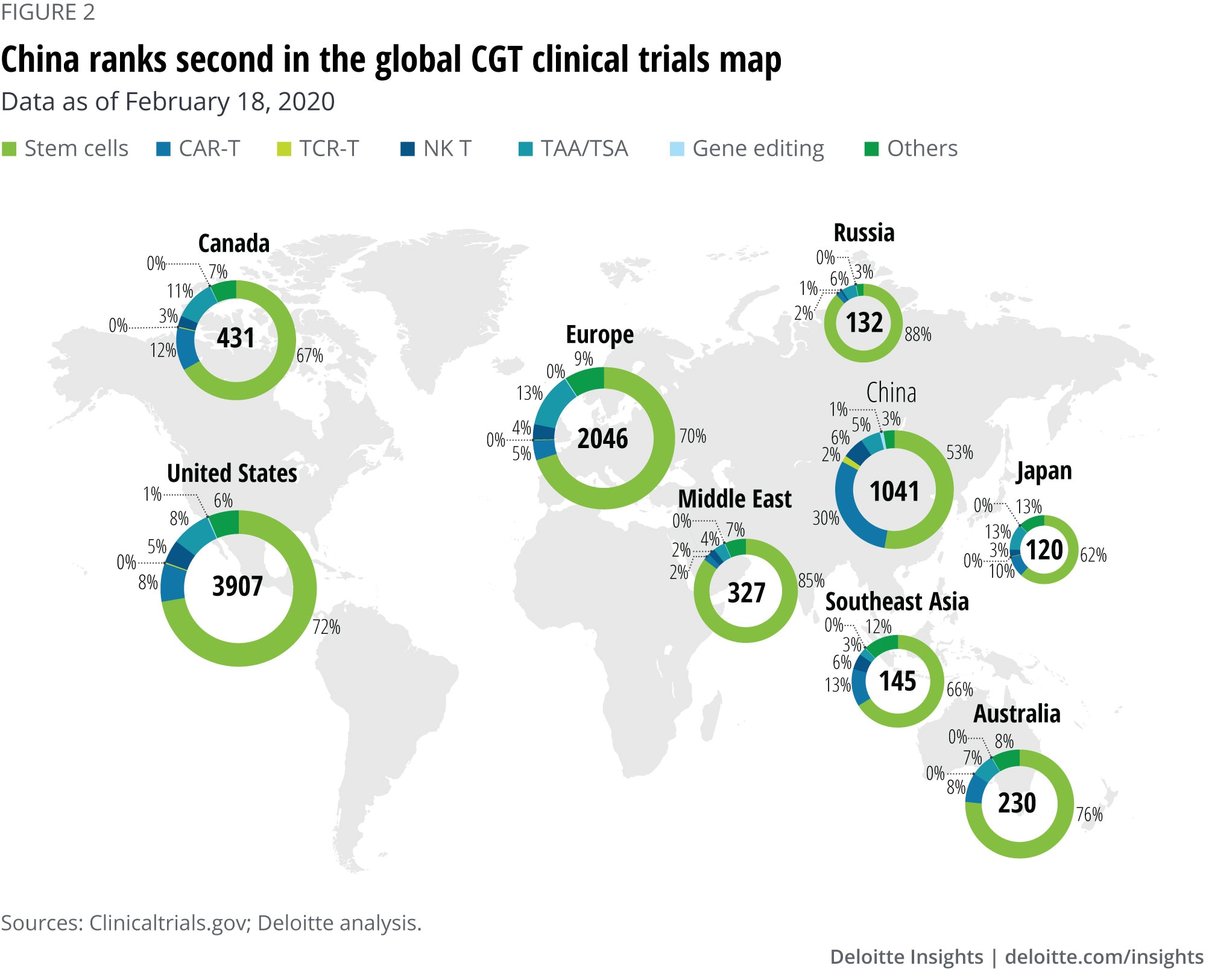
A maturing ecosystem promoting innovation and industrialization
A supportive policy environment has catalyzed the formation of an entire ecosystem around CGT—patents are being developed at unprecedented speed; regional infrastructure such as cell storage and manufacturing facilities are being built; multilateral collaborations between academics, biotechs, and government are being formed to develop industry standards; and private capital inflows have increased (figure 3). Leading local biotechs are at the center of this ecosystem, working actively with all key stakeholders in the value chain to develop the ecosystem.
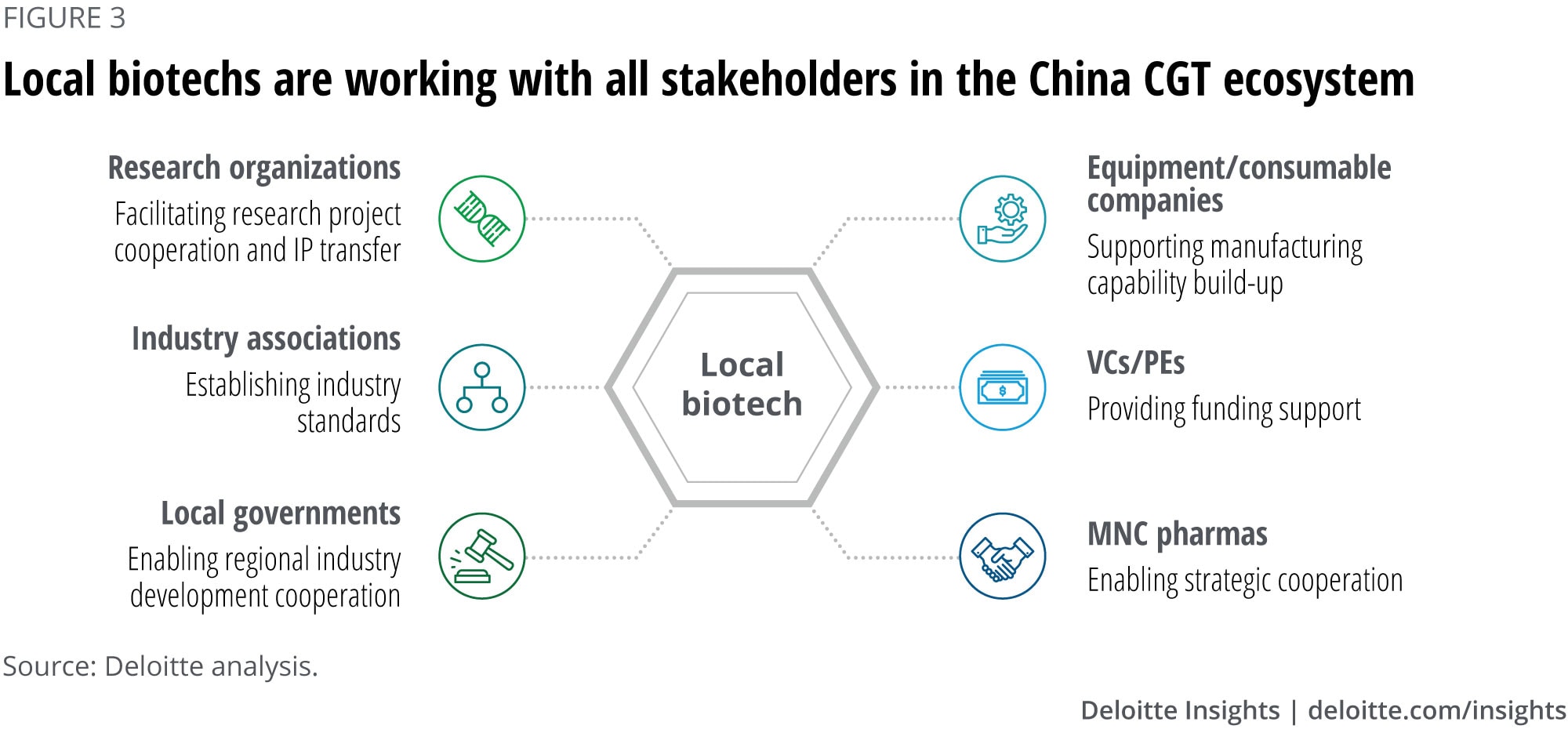
Start-up boom
Propelled by supportive CGT policies, the local biomedical research boom has generated more than 3,000 patents related to CGT.21 Many key opinion leaders (KOLs) at top research institutes are licensing these patents to local biotechs for further R&D. For instance, Jianxiang Wang, deputy director of the Institute of Hematology of Chinese Academy of Medical Sciences, sold two patents related to CAR-T preparation techniques targeted at CD33 and CD19 (CD stands for cluster differentiation; both CD33 and CD19 are well known surface antigens implicated in blood-borne cancers) for ALL treatment to Vcanbio22 for US$8.7 million in 2016.23
Other KOLs are commercializing these patents through their own biotech ventures. For instance, Wensheng Wei, a professor at the School of Life Sciences of Peking University, founded EdiGene in 2015 based on his research in high-throughput gene screening using CRISPR-Cas9 technology. The startup has multiple gene-editing assets, including one targeting β-thalassemia, already preparing for IND application filing. It has attracted US$10 million in series A funding and US$35 million in a pre–series B round of VC funding.24
Startups based on innovative technologies and high-profile teams from overseas are also raising large amounts of capital from renowned local investors, some even during early rounds of financing. For example, JW Therapeutics, a joint venture (JV) between Juno and WuXi AppTec, raised US$90 million from Temasek and other investors in round A.25 The company is a leader in CAR-T treatment, the second candidate applied for marketing in China.26
A time for collaboration
Local biotechs are collaborating with industry associations to develop product quality and manufacturing process standards with an aim to guide industry evolution. For example, Sailiai,27 a leading stem cell startup, is working with the China Quality Association for Pharmaceuticals to push for the establishment of stem cell industry manufacturing and quality standards.
Local governments, meanwhile, are forming alliances with industry leaders to boost regional infrastructure. The Chinese government plans to build more than 15 regional stem cell centers, each with 5–20 million stem cell sample storage capacity, in the next three years. The goal is to support sample storage and production services for local scientific research, clinical trials, and, in the future, commercialization.28
Collaborations between local biotechs and multinational companies are speeding up as well. These tie-ups are taking the form of licensing and JV partnerships to ensure speed in product registration and access to local manufacturing and commercialization capabilities; for instance, JVs such as Fosun/Kite and Juno/WuXi AppTec. Others such as the Johnson & Johnson (JnJ)/Legend partnership focus more on licensing agreements of local innovative technologies for global commercialization (figure 4).
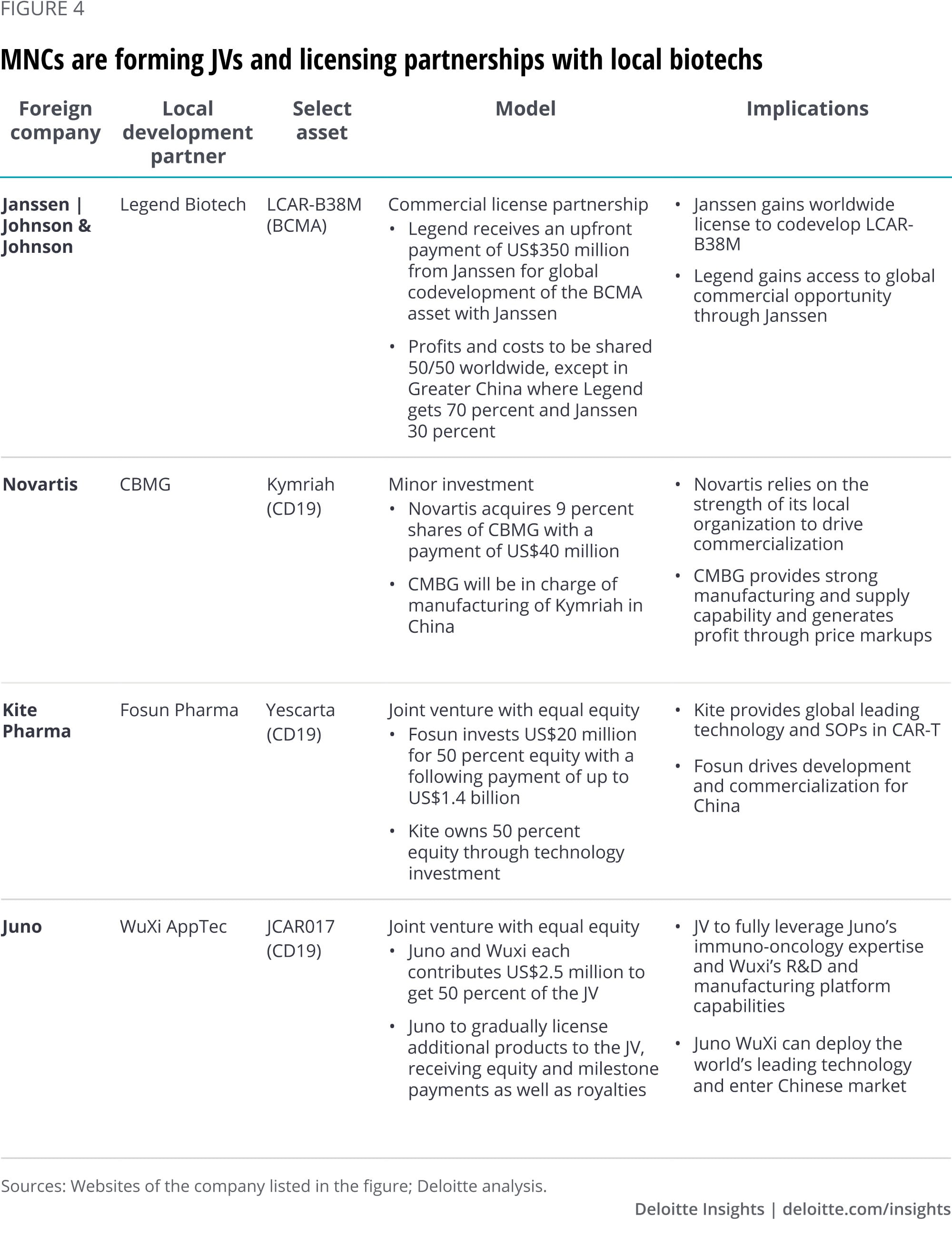
With the commercialization of the first wave of cell therapies looming on the horizon, reagent and equipment suppliers such as ThermoFisher, GE, Terumo BCT, and Miltenyi Biotec are working closely with leading CGT players to industrialize cell therapy process automation. For example, GE has signed a strategic partnership with the Cellular Biomedicine Group (CBMG) to develop a center of excellence (CoE) on smart end-to-end cell therapy manufacturing. Such partnerships will play a critical role in turning labor-intensive cell therapy production processes into scalable, cost-effective processes for commercial use.
Overcoming challenges and mapping a success strategy in CGT
Although the policy, market, and ecosystem forces at play are causing a massive surge in the growth of the CGT sector in China, uncertainties and challenges still remain. Some of these roadblocks are:
- Heavy protection and oversight of local genetic resources
- An increasingly crowded CGT pipeline, especially on the autologous cell therapies side, within a relatively concentrated set of target diseases and biological targets
- High level of local regulatory and market access uncertainties
- A health care provider system that is inexperienced in CGT products
Companies aspiring to win in China’s CGT market will have to create a successful strategy that addresses these challenges while charting out their product development and commercialization journey. A good way to start would be to consider the following questions:
Market entry: What entry models are permitted given current policy constraints related to CGT investments by foreign entities and the use of Chinese human genetic resources? Is there an opportunity to leverage local partnerships for entry?
Product and patent portfolio: What drives product differentiation for China? Is there a tangible opportunity to access local innovation for global development?
Regulatory path: What drives regulatory excellence in China to maximize speed to market? Is there an opportunity to create early-access programs for patients and physicians?
Commercial viability: What barriers are preventing commercial CGT products from reaching their full potential in China? What unique solutions and capabilities are required to drive commercial success for CGT product launches?
And here are some of the probable answers to these questions:
Market entry through partnerships in a protected CGT sector
Beyond making significant progress on the regulatory approval requirements for CGT products, China has also developed an overall regulatory framework to protect and nurture the local CGT industry. The key regulatory measure taken in this regard is posing various restrictions on market entry, materials transfer, and data privacy. Here’s what companies need to know in this regard:
Navigating the Negative List
The 2019 Negative List29 published by the Ministry of Commerce and National Development and Reform Commission, generally forbids foreign investments in “human stem cell, genetic diagnosis and (gene) therapy related technology development and application.” However, the actual interpretation and implementation of the policy is carried out by the NMPA and the Ministry of Science and Technology, where consideration is given to different types of CGT products. For example, autologous cell therapies such as CAR-T are allowed to enter the market through JV partnerships (Fosun/Kite), while certain biological regimens, such as Biogen’s Spinraza (a nucleotide drug that controls mRNA splicing and the expression of survival motor neuron protein), are classified as a conventional biologic product rather than gene therapy.
To effectively navigate the Negative List, foreign entities looking to enter China need to actively consult and educate government agencies to understand whether the restrictions will and should apply to their products. Accordingly, they need to assess and choose from the range of entry options: wholly owned (Biogen), JV (Kite/Fosun), minority investment (Novartis/CBMG), and commercial licensing agreement (JnJ/Legend on LCAR-B38M).
… and choosing a model for entry
The majority of models mentioned above tap into local partnerships that not only enable a foreign entity to navigate policies, but also give them other strategic advantages. Some of these benefits are: channel coverage and government affairs (Kite/Fosun),30 new manufacturing technologies (Novartis/CBMG),31 and local innovative CGT assets (JnJ/Legend).32
While considering which entry model/s to use, besides evaluating the potential benefits from a partnership, companies must also consider how to effectively mitigate local risks by:
- Leveraging a combination of contractual agreements, project governance, and supply chain models to safeguard their core IPs and know-how, while ensuring quality consistency for localized production.
- Mitigating genetic data compliance risks by properly localizing the data infrastructure while limiting the transfer of patient-level genetic information overseas.
We believe the mandate for partnerships will continue to strengthen as more local biotechs are upgrading their core competencies including manufacturing capacity, IP practice, and quality management standards. For example, Immuno China is building its digital cell-treatment-tracking platform based on the ThermoFisher Platform for Science (PFS), a cloud-based data management infrastructure.33 The efforts made by CBMG to build a smart factory for cell therapies using digital solutions, semi-automation, and analytics show that leading local players are already at the forefront of cell therapies industrialization.34
Reinventing the crowded pipeline: Diversify portfolio to meet unmet local needs
Most CGT products are positioned as a one-time cure for intractable diseases—such as genetic disorders or end-stage hematological ailments—with a rather small pool of patients. This implies that a CGT company will need a robust portfolio of products, likely targeting multiple diseases with different types of products, in order to be sustainable. CGT products must also compete with biologic immune-oncology products that target checkpoint inhibitors. While these therapies can be effective in slowing the progression of disease, they are not curative.
The current clinical study pipeline for cell therapies in China still has much potential for improvement—and innovation. It is relatively crowded. Take CAR-T, for example—more than 69 percent of the studies target hematological tumors such as lymphoma or leukemia, of which more than 54 percent target CD19.35 Thus, it is imperative that companies cultivate a more differentiated and innovative product pipeline. To this end, companies should:
- Consider targeting diseases with more specific local unmet needs, as Chinese patients have a different disease spectrum. For instance, Oncorine,36 the world first oncolytic virus medicine, was launched in 2006 for nasopharyngeal carcinoma, which has a higher incidence in China. Within oncology, there are many differences in the prevalence of cancer types between China and the United States (figure 5).
- More aggressively access local scientific innovation (figures 6a and 6b), in addition to technology transfer from overseas. Bring onboard therapies with innovative, next-generation technologies (for example, allogeneic over autologous cell therapies.)
Companies will need to strengthen their local market intelligence and medical affairs practice to derive more insights into the unique therapeutic opportunities in China. They will also need to build deeper connections with the local research community, not just through conventional business development or licensing activities, but by forming research collaborations, venture investments, or even providing contract CGT research services to speed up new technology identification and validation.
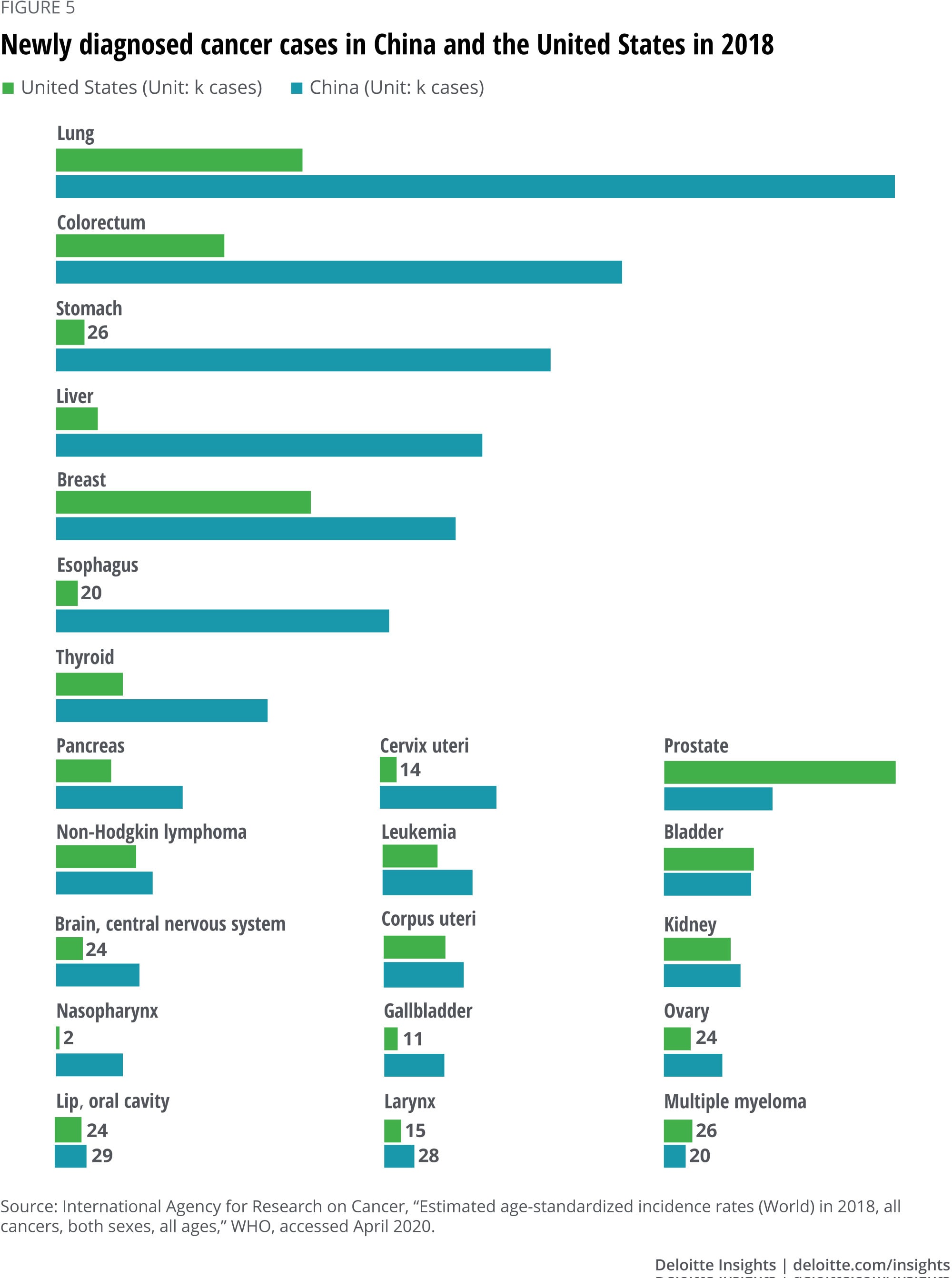
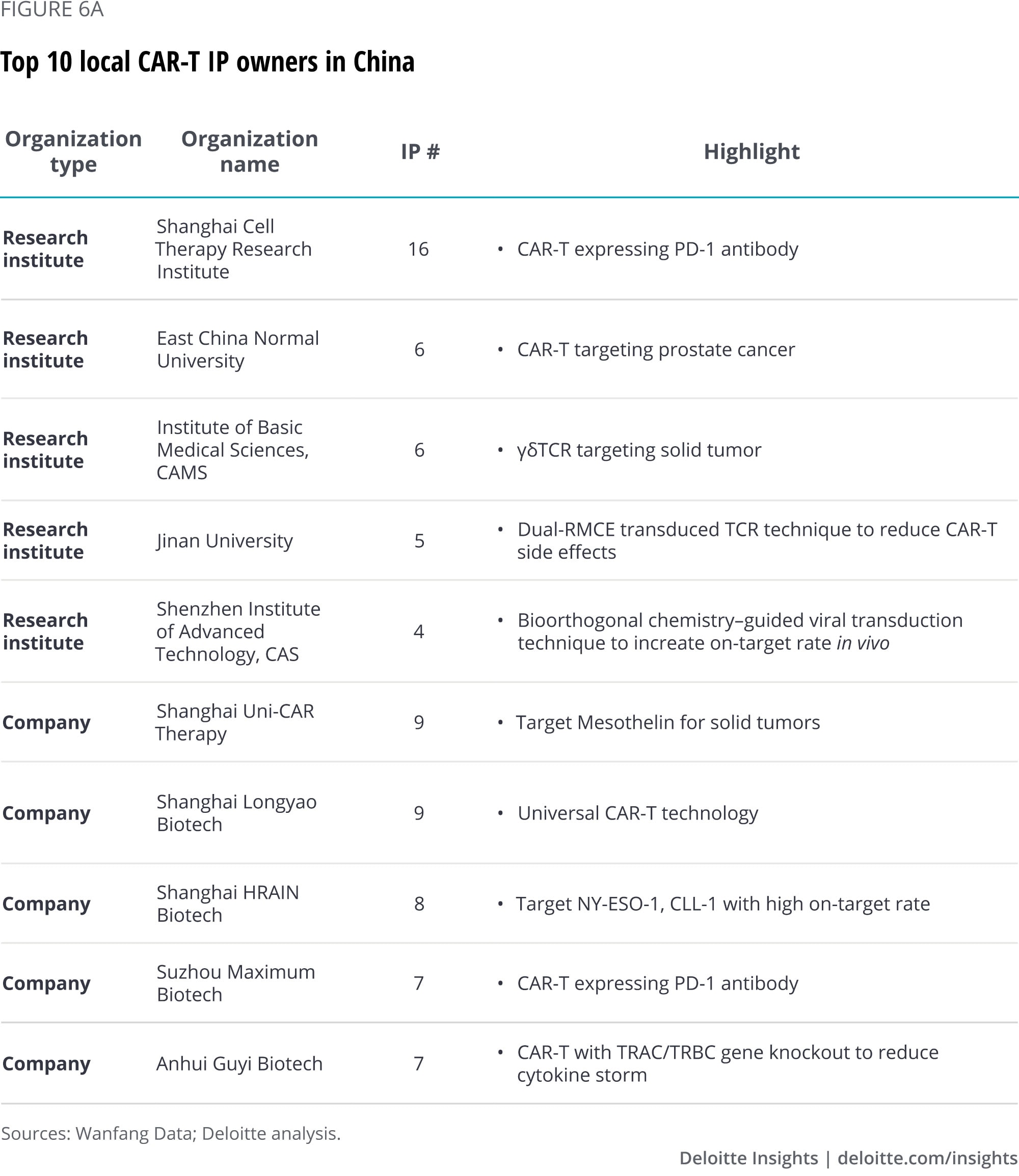

Accelerated registration and early-access opportunities
The potential of CGT to fundamentally shift the treatment paradigm and deliver cures for many intractable diseases would mean that the potential for accelerated registration of CGT products is for real (figure 7). This is because treatments that meet urgent clinical needs are reviewed with high priority according to local policies.37 In a previous whitepaper, Deloitte discussed various strategies to accelerate product registration.38 Regulatory affairs professionals handling CGT programs will need to orchestrate a strong effort in communicating the clinical unmet need to the Center for Drug Evaluation (CDE). They should also leverage existing clinical study data as well as real-world evidence (RWE) to establish the disruptiveness or safety of the therapy in question to speed up local product registration.
Meanwhile, companies need to explore early-access programs for local patients in China even before registration. In the Hainan Lecheng Medical Pilot Zone, drugs with urgent clinical needs that haven’t been approved by the CDE can be accessed through Hainan FDA approval, and the generated real-world data (RWD) can be used in the subsequent national NDA filing. Till January 2020, the Lecheng Pilot Zone had granted early access for 51 drugs and medical devices from more than 10 MNCs to 253 patients.39 This includes Keytruda (a checkpoint inhibitor) from Merck Sharp & Dohme Corporation (MSD).40 Similar pilots from other cities, such as the Shanghai Hongqiao Medical Pilot Zone,41 offer even stronger prospects for early-access programs to CGT due to greater maturity of the local health care system.
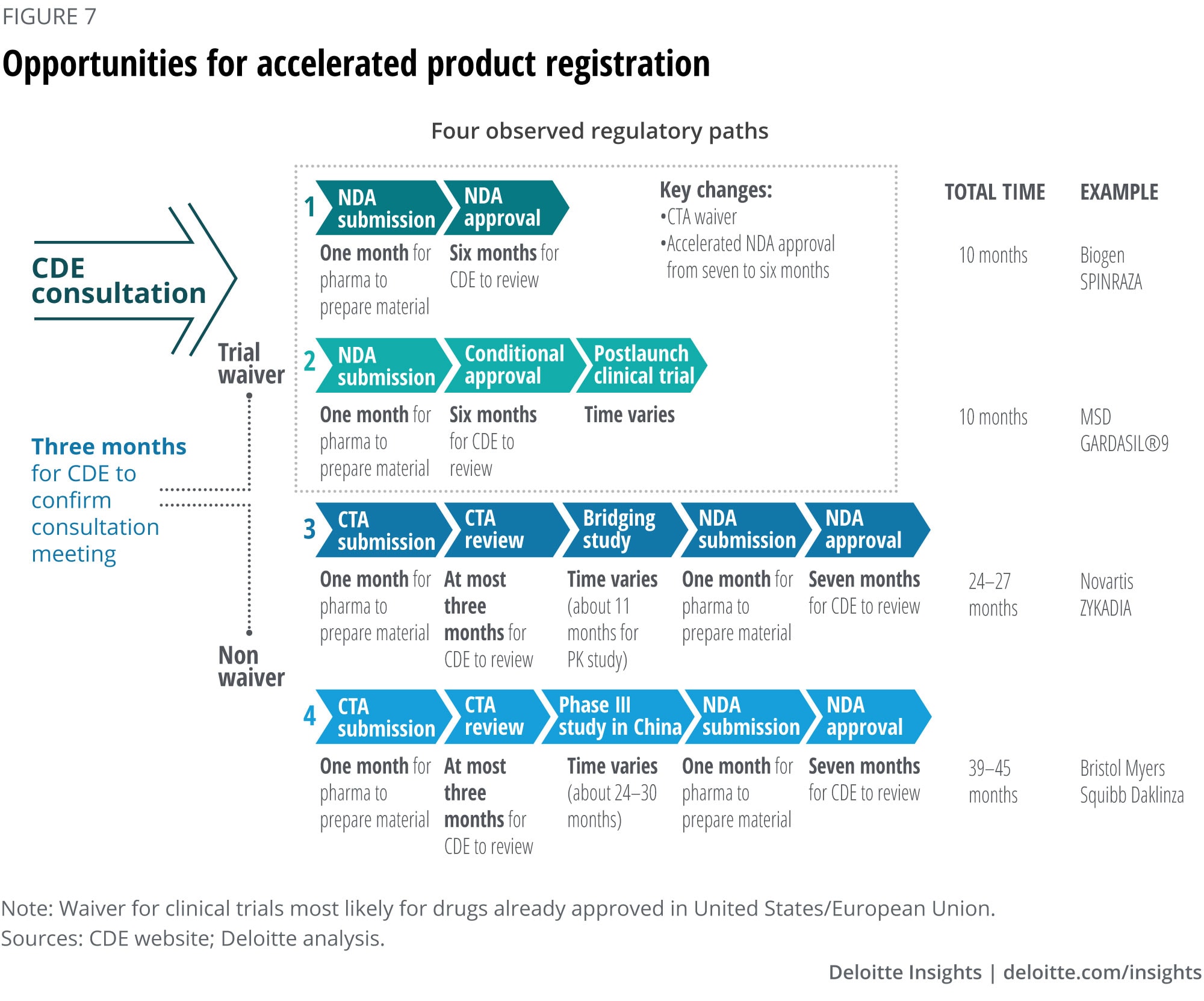
Turning the CGT opportunity into commercial success
Having the right market entry model, the optimal product and IP portfolios, and an accelerated registration strategy are only the first steps. To really seize the opportunity for commercial success in China’s CGT sector, companies need to plan ahead and make elaborate product launch preparations. In fact, planning for CGT products needs to be done far more in advance than for conventional drugs. This ensures that health care providers are proficiently trained in using CGT products; supply chain infrastructure is properly localized to manufacture CGT high-quality products; and innovative reimbursements such as instalments can be used to drive meaningful patient access. The key steps a company must take are:
Build a network of provider capabilities around the optimal use of CGT. Many CGT products, such as CAR-T or stem cells, are different from conventional treatments in more ways than one.42 They usually have very stringent patient enrollment criteria and require highly cross-departmental teams including nursing, intensive care unit (ICU), neurology, pharmacies, etc. to render both pre- and after-care safely. They also necessitate much closer engagement between the chief physician and the patient to manage the latter’s high expectations from the therapy. Meeting these goals is not easy in China due to unique local challenges, such as:
- Lack of robust national referral system. China still lacks a robust referral system in specialty care at the national level, which can result in insufficient referrals or referrals of patients unsuitable for cell therapies.
- Shortage of experienced health care professionals (HCP) and limited interdisciplinary collaborations. Chinese public hospitals have a department-wise P&L system, because of which they have struggled traditionally to boost multidepartment collaborations. Such collaborations are critical for cell therapies, especially while managing adverse events.
- Limited HCP-patient interactions due to limited capacity for patient management. This may result in high occurrences of patient compliance issues during the treatment journey (for example, inadvertent use of immune-suppressing agents before apheresis by patients can affect the quality of apheresis) and suboptimal treatment results.
- Lack of well-established electronic health records (EMR) system.43 EMR systems in most hospitals are developed in an uncoordinated manner with insufficient data integration and data-sharing. Yet, they are essential to track complex treatment algorithms for CGT.
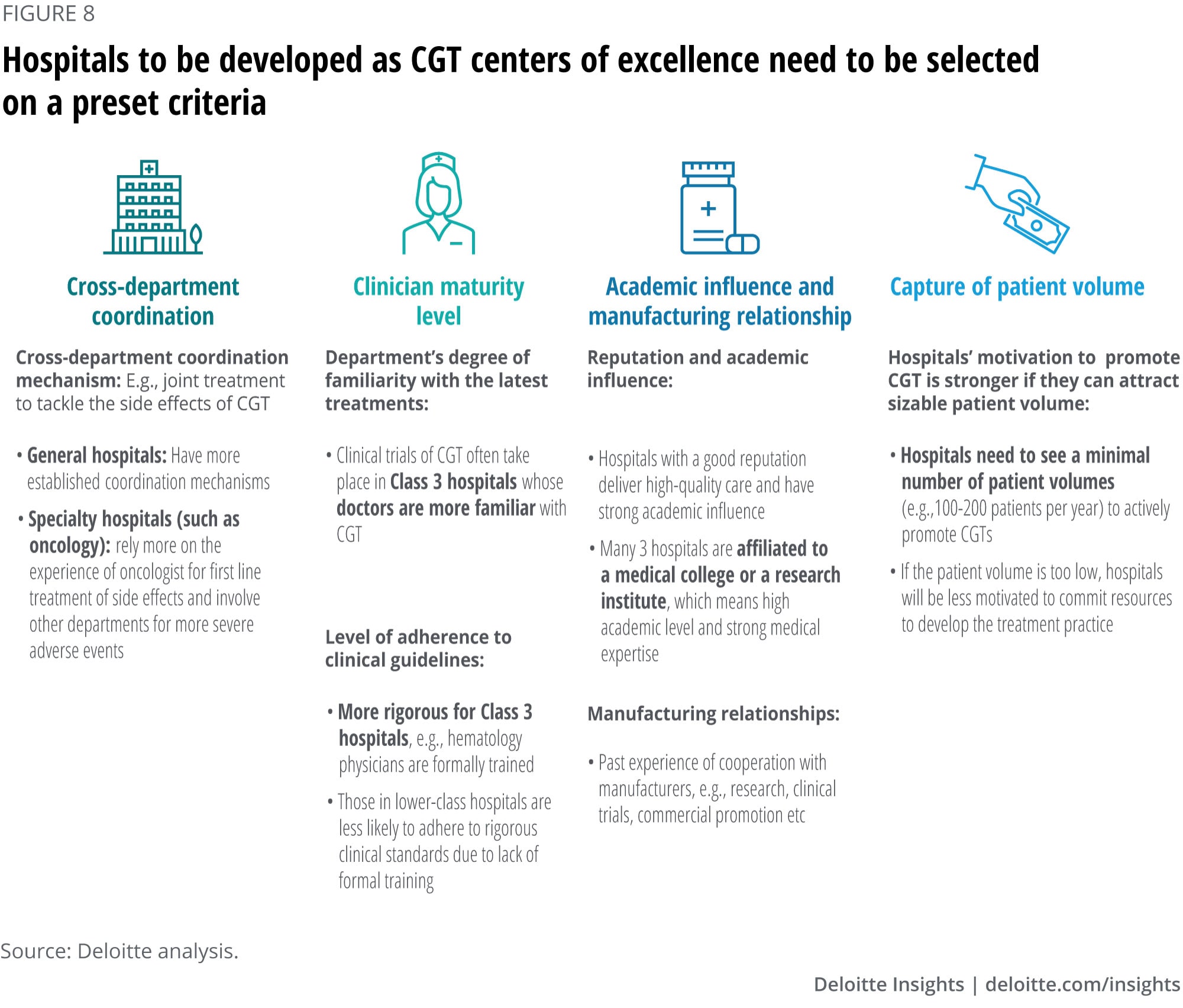
Manufacturers need to plan early and plan well to address these challenges. Even during the clinical trial stage, companies need to carefully select hospitals across geographies to enroll for clinical studies based on robust preset criteria (figure 8). They need to assess hospitals to see if they can be partners in codeveloping a set of operating manuals for best practices in patient enrollment assessment, consent discussion, treatment process, and inter-department coordination. Hospitals that meet the requirements can be established as regional CoEs to propagate the standard of CGT care to surrounding hospitals. Furthermore, companies should also help these CoEs build a proper local referral network by designing efficient patient screening and referral processes.
Early prototyping of the end-to-end manufacturing process. The transition from clinical trial of cell therapies to commercial stage production would require companies to establish a highly standardized industrial process, yet companies that succeed in securing regulatory approval often struggle to anticipate and prepare for the challenges of commercial manufacturing.44 Take, for instance, the delayed launch of Zynteglo, a gene therapy product for β-thalassemia,45 by Bluebird Bio, a US-based biotech developing innovative gene therapy products. Bluebird secured regulatory approval for the gene therapy in 2019 in the European Union but had to delay launch till 2020 because of a manufacturing specification hiccup.
To overcome this problem, cell therapy companies need to gear up for prototyping an end-to-end manufacturing and logistics process early during the R&D phase. Specifically, manufacturers need to develop a process that is contamination-free and can produce cells with high viability and high yield. The process should automate certain labor-intensive steps to drive-down batch-to-batch variations while reducing time. Manufacturers also need to ensure that the processes are flexible—for instance, they are modular and programmable—so they can be further optimized as new areas of improvements are identified with accumulated knowledge.
Specifically, in the case of autologous cell therapies, manufacturers will need to carefully evaluate building solutions across critical steps of the process—cell separation, activation, transfection, expansion, etc.—from medical device companies (figure 9). Medical device companies, on the other hand, need to beef up their product portfolio; drive more value-demonstration programs with strategic CGT partners; and explore innovative revenue models such as risk-sharing programs, based on their ability to capture scale/cost benefits. What’s more, it’s important for manufacturers to build sufficient human capital with the experience in the different types of manufacturing specialties needed for CGT.
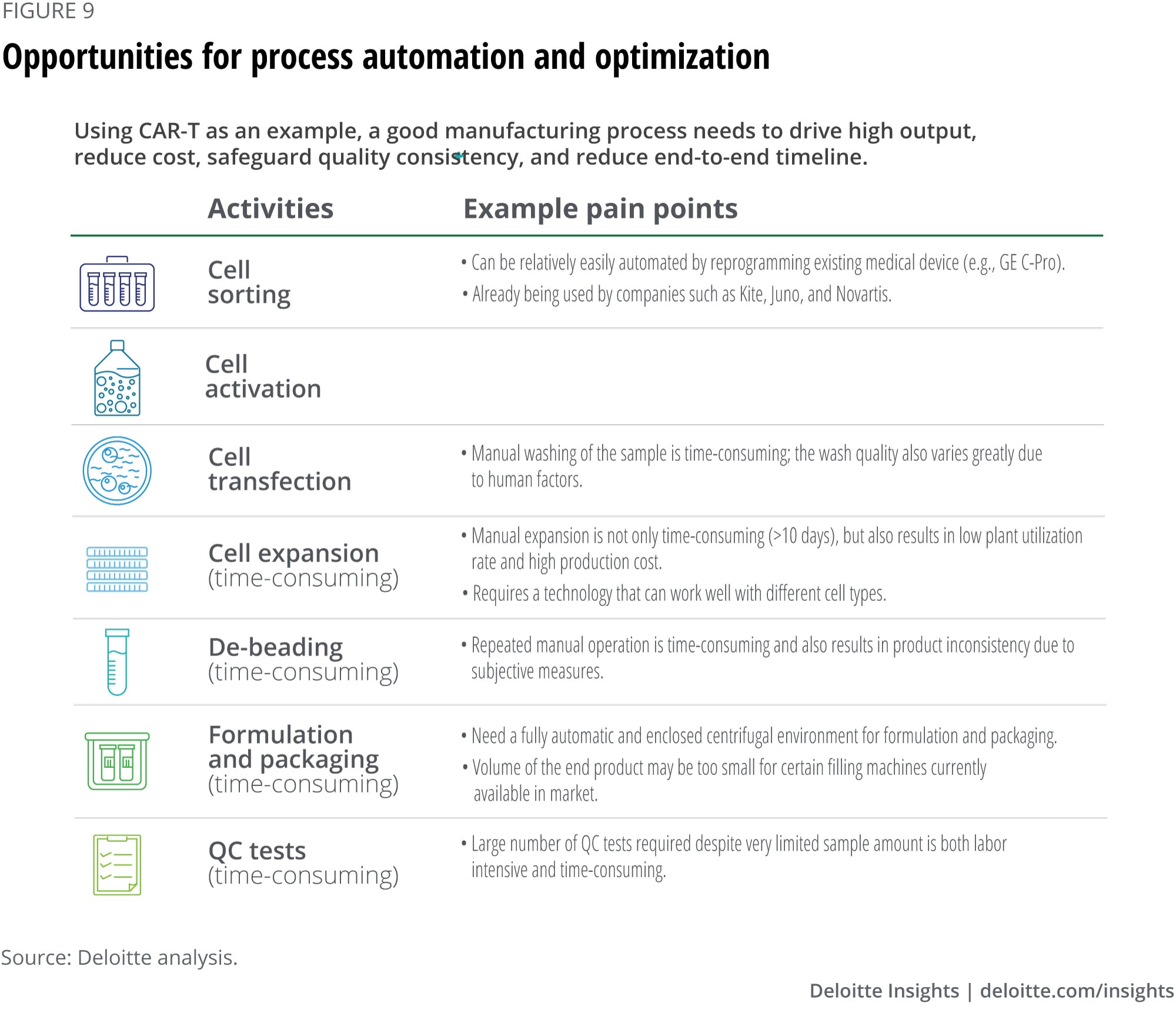
Balancing compelling product value while addressing local access gap. CGT promise durable clinical benefits through a potential one-time cure. This unique clinical profile of the therapies directly implies high upfront costs for payers and patients. In the case of Kymriah (a CAR-T therapy for leukemia/lymphoma), the label price for a one-time treatment in the United States is US$ 475,000,46 or 46 times the per capita GDP in China (US$ 10,276 in 2019).47
Apart from the poor out-of-pocket affordability for most Chinese people, the National Reimbursement Drug List (NRDL), although increasingly financing more innovative therapies, remains highly uncertain for reimbursement of CGT, and will probably mandate heavy price cut in exchange for reimbursement (60~70% pricing cut during 2018–2019 rounds of NRDL negotiations).48 Companies must undertake a multi-pronged approach to drive meaningful patient access while ensuring the long-term sustainability for their CGT products in China by:
- Building local data and evidence programs early on (e.g., accumulating long-term patient follow-ups during the clinical trials stage) to enable early discussions on the unique value profiles of their CGTs with local clinical experts.
- Formulating an effective campaign to convey the unique value proposition of their CGTs to local payers. The aim is to help shape market access policy through extended partnerships with clinical experts, patient advocates, RWD companies, and health economics experts.
- Leveraging multiple funding options, such as provincial critical illness programs, patient assistance programs, and NGO donations, to address affordability gaps, while actively preparing for NRDL negotiations (figure 10).
- Exploring innovative payment models by addressing local stakeholder concerns. Such concerns could range from total treatment cost and upfront payment burden to managing uncertainties in clinical outcome or patient dispute risks. To this end, companies can learn from various innovative payment models adopted in the United States, European Union, and Japan (figure 11).
- Adopting scenario planning for different market access/reimbursement scenarios; understanding their impact on market uptake and commercial go-to-market models.
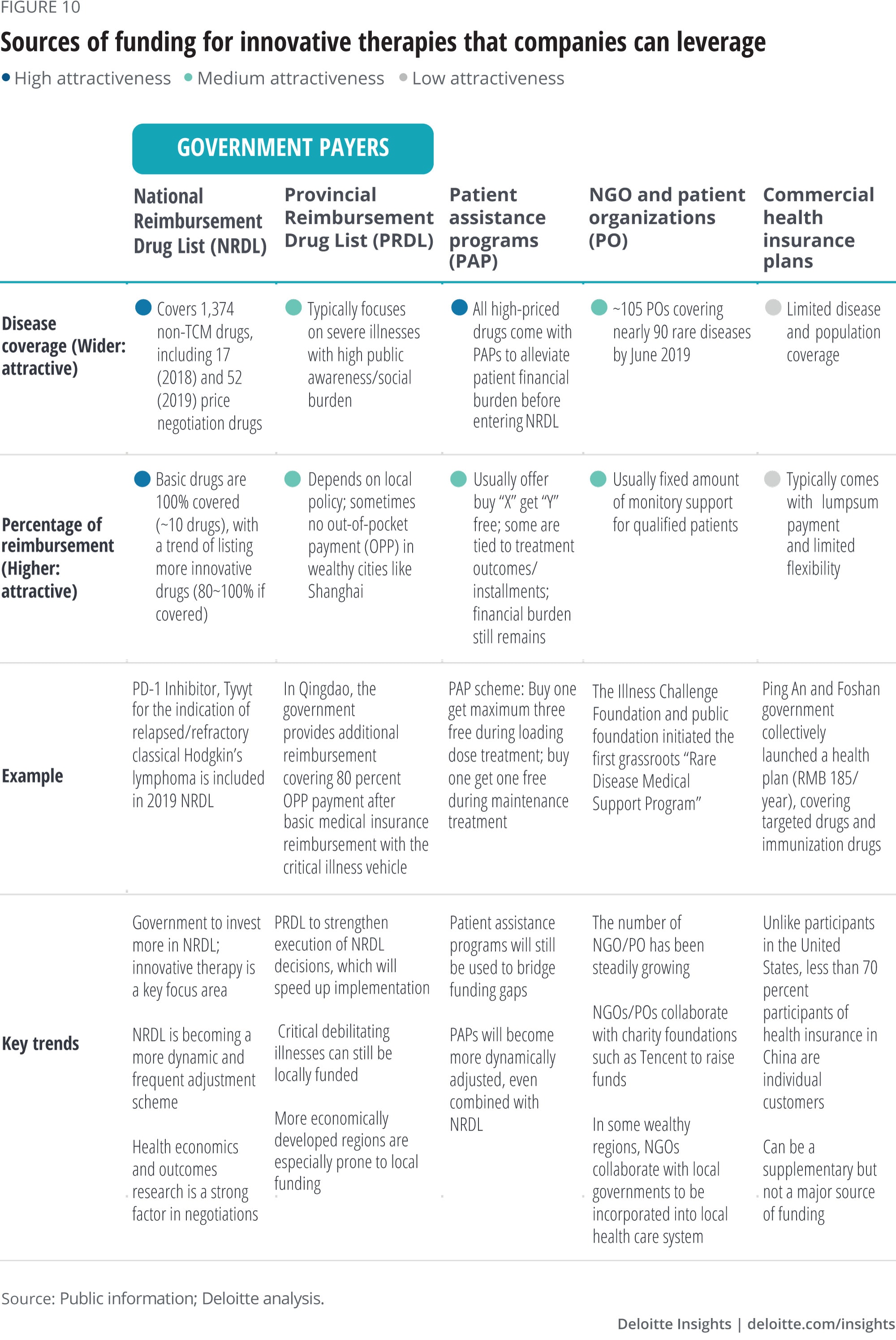
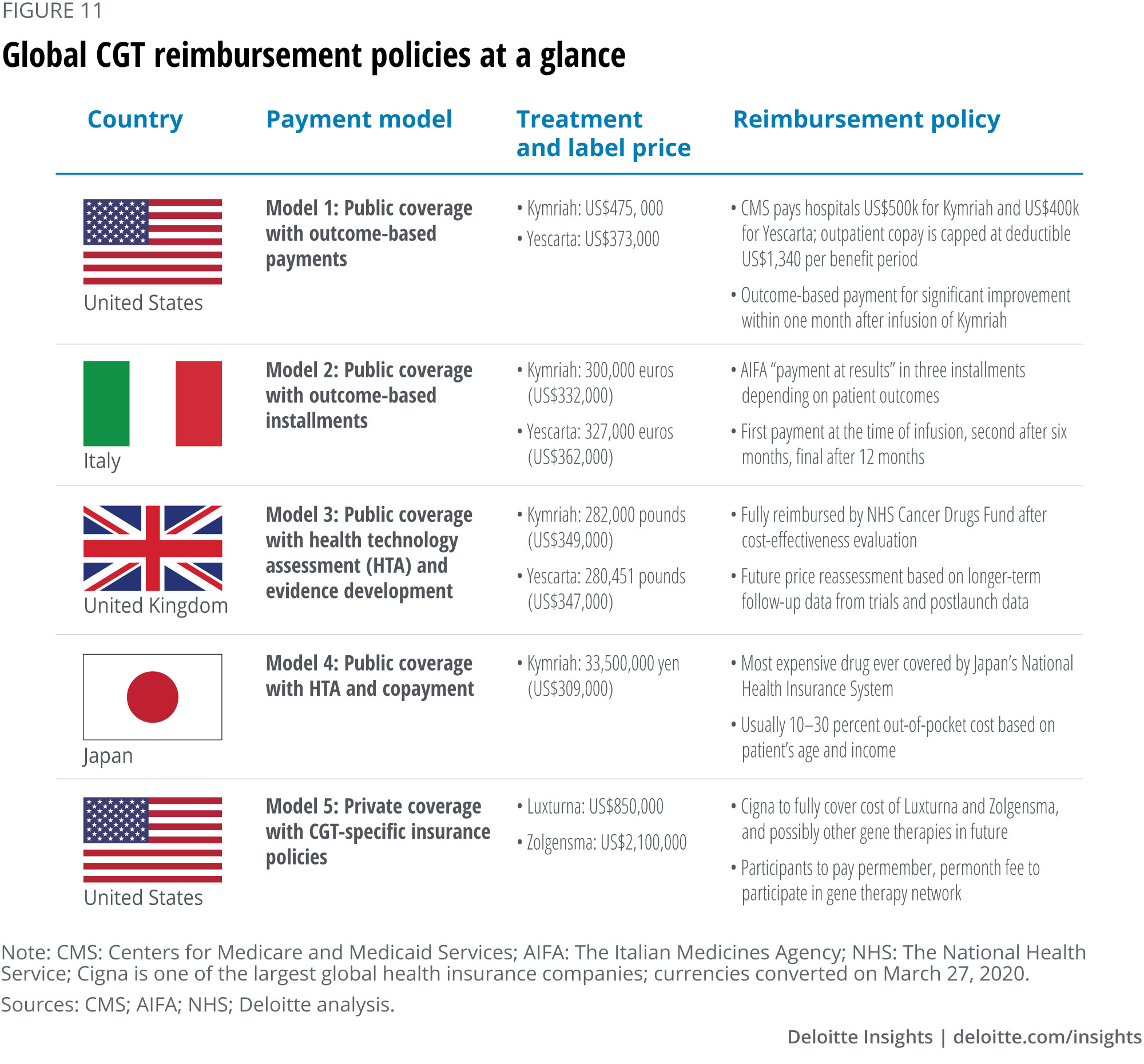
CGT success: Building a matrix of excellence
With more than 800 clinical studies49 in autologous cell therapies, stem cell, and gene editing ongoing or completed in China, there is little doubt that there is a real—and huge—opportunity for China to benefit from the global CGT innovation, but also to contribute its own innovation to other global markets. However, there is still much to be done to fully deliver on the promise of China’s CGT sector. Companies should consider building a four-pronged matrix of excellence:
Market entry excellence: Chinese regulations, such as the Negative List and human genetic resources, have created a strong case for CGT entry through partnerships, but one needs to conduct a thorough assessment of potential partners as well as evaluate different partnership models based on risk/reward considerations. Factors such as regulatory compliance, speed-to-market, access to local innovation, protection for IP, and product quality control are critical when deciding on the optimal entry models.
Portfolio and IP excellence: Companies can achieve CGT portfolio and IP excellence through development programs that differentiate either through technology or through choices of diseases. In China’s CGT market, there are increasing opportunities for in-licensing for both overseas companies as well as leading local biotechs and academics. All companies will need to strengthen their collaborations with leading academics and invest in more translational research in order to build a robust IP portfolio.
Regulatory excellence: Companies can navigate this all-important area by proactively engaging with the relevant authorities on local registration path and launching optimal clinical programs to ensure maximum speed-to-market in China. In addition, for products already launched in other markets, companies should explore early-access programs to accumulate precious local data and evidence earlier.
Commercial excellence: To ensure that scientific advancement can be translated into tangible patient and commercial outcomes, companies will need to consider:
Health care provider partnership excellence: Develop a robust CGT site selection and preparation program even during the clinical stage and build a CoE and referral network for product launch.
Localized manufacturing excellence through early process prototyping that allows for optimizations based on inputs from clinical studies; actively partner with medical device manufacturers on process optimization. Have a robust assessment on manufacturing activities parked globally versus locally to ensure IP protection as well as optimal patient experience.
Market access excellence through localized innovative pricing and reimbursement programs. Actively explore regional reimbursement programs while preparing for NRDL with value propositions based on local evidence.
IT platform excellence to facilitate the delivery of comprehensive training and certification programs to hospitals while enabling the management of complex workflows for cell therapies to safeguard product quality.
The journey to excellence in China’s CGT market may be long and winding, but it is full of promise. Companies and investors with a unique China-focused strategy spun around the matrix of excellence are likely to be a step ahead in the country’s CGT market.
© 2021. See Terms of Use for more information.
Explore more on life sciences
-
Intelligent clinical trials Article5 years ago
-
New payment models in medtech Article5 years ago
-
Drug and inpatient spending lines are crossing Article5 years ago
-
Striving to become more patient-centric in life sciences Article5 years ago
-
2021 global life sciences outlook Article3 years ago














